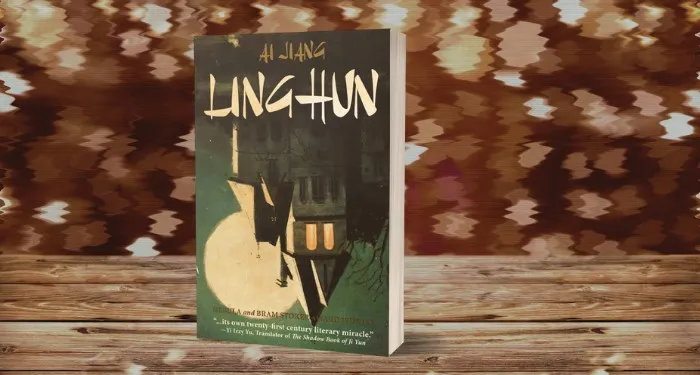It begins with a white chair slowly gliding across the stage behind a giant gauze curtain. Then two dancers emerge, one from each wing, approaching one another as they edge into view. Projected images of the ocean—a montage of footage and still photographs—flicker on the curtain. A voice-over, glitching slightly, speaks in a calmly undulating rhythm in counterpoint to the languid waves. “For a photograph we need a wall./Star gazing./Photographs are small. They reproduce well./I enlarge better.”
The words are from Gertrude Stein’s short 1920 text “Photograph: A Play in Five Acts”; the speaker is Lucinda Childs, the eighty-five-year-old dancer and choreographer. Stein, her latest work, made in collaboration with the Dance On Ensemble, premiered in July at Berlin’s Radialsystem, a former pumping station on the banks of the Spree. Although Stein called “Photograph” a play, it contains no plot, character, or stage direction: its verbal acrobatics emerged out of her intense study of how words make and convey meaning. In “Photograph” language itself is a hero-protagonist, a character restlessly working to transform and renew itself: “A language tires./A language tries to be./A language tries to be free.”
Stein’s soundscape of piano improvisation and drone noise, devised by Childs’s longtime collaborator Hans Peter Kuhn, chimes hauntingly both with Childs’s delivery and with the slow, swirling movements—by turns flowing and jerky—of the two dancers: Childs and Miki Orihara, a Martha Graham principal. While Orihara, in front of the curtain, deftly covers the space with spins and strides, Childs remains behind the screen, her gestures precise and restrained, circling the chair as if contemplating its possible uses. As the chair retreats back across the stage, Childs stretches her arms upward and intones “A play means more,” elongating the vowels into a deep howl. On the page Stein’s plays reject meaning, but when read and heard aloud, their opaque utterances become profound. As Childs speaks, ideas and images start coming into focus, coalescing into a study of the perceptual process itself.
Stein marks an unusually direct engagement on Childs’s part with the work of this titan of the early twentieth-century avant-garde. But Stein’s influence runs across Childs’s long career. It’s discernible in her intricate, deceptively simple patterns, her combination of precision and surrealism, and above all her longstanding interest in repetitive structures, which propelled her landmark collaborations with the director Robert Wilson and the composer Philip Glass on their opera Einstein on the Beach, and with Glass and the artist Sol LeWitt on a minimalist ballet called, simply, Dance.
Childs emerged from a milieu—the aesthetic revolution in downtown 1960s New York—where Stein’s radical work was very much in the air. It was coming back into print thanks to the efforts of Dick Higgins’s Something Else Press, which reissued several of her books—including the first complete US edition of her 1925 epic The Making of Americans—over the course of the decade, setting them alongside contemporary volumes by artists including Ray Johnson, Allan Kaprow, and John Cage. Her plays Ladies’ Voices and Dr Faustus Lights the Lights had been staged in 1951 by the anarchist company the Living Theatre—an important precursor to this downtown scene—which saw Stein’s efforts to revivify language as a blueprint for their own. Cage had been reading Stein and setting her texts to music since his school days; he and his partner, the dancer and choreographer Merce Cunningham, both urged their students to learn from Stein’s work and take its principles forward.
*
In 1963 Childs was a young dancer involved with Cunningham’s New York City studio when Yvonne Rainer invited her to join a loose collective of dancers working out of the Judson Memorial Church on Washington Square. The church’s basement gallery had already hosted early Happenings, events (sometimes spontaneous, sometimes carefully choreographed) without plot or traditional staging: a maze of torn newspapers and chicken wire, devised by Kaprow, leading to a sanctum containing a circle of artificial fruit lit by a single lightbulb; naked bodies strewn on the floor as the artist Claes Oldenburg read The Scarlet Letter out loud by candlelight.
It was here that the group developed an avant-garde language for dance. Drawing on a wide array of forms and media, from Cunningham’s choreography to the music of John Cage, the happenings of the performance art movement Fluxus, and minimalist painting and sculpture, they rejected theatrical conventions—the burden on dancers to convey character and story; the expectation that a performance should take place in a proscenium theater, with a seated audience—and paid attention instead to everyday movements and experience. There was no manifesto, no unifying principle beyond a commitment to freedom, experiment, and the vitality of bodies moving. What happened at Judson, wrote the Village Voice critic Jill Johnston, was simply “the annihilation of all preconceived notions about dance.”
Childs made her debut with the group in Rainer’s We Shall Run (1963), a seven-minute piece for twelve dancers who trotted briskly, in shifting groups and patterns, to the strains of Berlioz’s Requiem. The following year, for Street Dance, she instructed an audience in a sixth-floor apartment to watch from the window while a cassette recording described the movements she was performing down below, turning the street into a stage and passersby into collaborators. Several Judson choreographers, taking a cue from Pop Art, used commonplace objects to generate drama: Rainer presented a work involving twelve mattresses that dancers lay on, leapt onto, and pushed around the stage; one of Childs’s earliest pieces, Carnation, saw the dancer wrestle with an array of domestic materials. “She sits at a small table with a visage of contained intensity,” reported Johnston, “contemplating a plan of action with foam-rubber curlers and sponges, as momentous as a call to battle.” The performance ended with Childs jumping furiously on a blue plastic bag—“a fanciful absurdity,” Johnston wrote, “of slight horror and some pathos.”
The same year Childs began to work with the Judson group, the church’s resident director, Lawrence Kornfeld, invited her and four other dancers to collaborate on a version of Stein’s What Happened: A Five Act Play (1913). Stein’s title is deliberately misleading. Responding to a question about a dinner party (“what happened?”), she set out to approximate the atmosphere, ceremony, and conversational din of a long evening’s conviviality: nonlinear, chaotic, impressionistic.
Kornfeld later recalled that the indeterminacy of Stein’s text allowed the dancers total freedom to respond organically to the words and the space. Together they came up with a stream of movements to emulate the linguistic games of the text, moving from playful beginnings (jumping, hopscotch, a waltz) to an eruption of joyful frenzy (suspicious sniffing of the audience, a pretend bath taken inside a grand piano). In one sequence the cast gathered behind the piano (which was being played by Al Carmines) and pushed it across the entire space, a tableau-in-motion that set the audience to spontaneous applause. As Rainer delivered Stein’s concluding lines—“A regret a single regret makes a doorway. What is a doorway, a doorway is a photograph…a photograph is a sight and a sight is always a sight of something”—the lights gradually faded and the performers slowly carried the piano offstage.1
The reception was rapturous. “The mime does not depict the verse, nor, in many cases, does it relate to the poem in any ordinary sense,” read one review. “But this is no ordinary production. The company has abstracted the Stein poem in the way Miss Stein abstracted reality.” It was a revealing observation. One of Stein’s most significant innovations was to treat words as living entities. She sought to divest them of the symbolic baggage they had acquired over the centuries, release them from syntactical constraints, and invest them with fresh life. In her sentences their positions would be dictated not by the rules of grammar or the requirements of narrative but by her own intuitive judgements. Her nonrepresentational use of words resonated with the Judson dancers’ focus on pure movement, in and for itself; they broke down dance just as Stein broke down language, forming something distinctly modern, vital, and new.
*
In the early 1970s Childs started developing her signature vision in a series of short dances with no sonic accompaniment, of which the Dance On Ensemble has been performing a suite in recent years under the title Works in Silence; members of the company presented three of them at Radialsystem before the premiere of Stein. Without any props or music, these mesmerizing pieces present the body moving in space. A small group of dancers dressed in utilitarian white suits perform a restricted set of movements in precise formation: walking, running, skipping, leaping, traveling in a circle or along strict, geometric lines. The only sounds are their increasingly heavy breathing and the pounding of their feet on the floor.
The spellbinding effect of Works in Silence comes from the subtle ways in which the same gestures change as the dancers converge in different groupings, speeding up or slowing down their movements, visibly tired. The result is all the more exuberant for its ostensible simplicity: it can be almost hypnotic to watch a dancer accelerate in preparation to overtake another or muster the energy to imbue yet another roll with the same kinetic force as those that came before. Rainer was among the first to note the expansive possibilities of Childs’s choreography. After seeing an early version of one of these dances, “Untitled Trio,” in 1968, she wrote to praise Childs for her “extraordinary sense of the limits of a choreographic situation—and by that I don’t mean limitations but rather how far you can go with a given set of materials.”
Watching the dancers in Berlin, I thought of Stein’s belief that “if anything is alive there is no such thing as repetition.” As a student of psychology at Harvard under William James, Stein had observed the differing habits of attention she saw in friends and acquaintances: “I began,” she wrote, “to get enormously interested in hearing how everybody said the same thing over and over again with infinite variations…endlessly the same and endlessly different.” Her early writing—Three Lives (1909), The Making of Americans, and the short texts she called “portraits”—advances through insistent cascades of repeated words and phrases. In her 1926 lecture “Composition as Explanation” she described The Making of Americans as “almost a thousand pages of a continuous present.” The epic novel is propelled not by the development of a plot—which Stein continually raises as a prospect then abandons—but by the slight nuances in phrasing that attune the reader’s ear and eye to the sounds and rhythms of the text. Childs’s work, too, holds the viewer in the moment and dramatizes the experience of time passing even as it seems to stand still.
Across the 1970s and beyond, Childs probed the possibilities of repetition with a vigor that would have thrilled Stein. For the first iteration of Wilson and Glass’s Einstein on the Beach, in 1976, she performed a solo dance along a diagonal line for forty-five minutes, repeating a series of gestures in a changing sequence, deeply evocative of Stein’s cadence. The five-hour opera seemed to take a formal cue from Stein’s idea, articulated in her 1934 lecture “Plays,” of a play as a landscape structured not around narrative but around space and time. (Wilson later wrote that reading Stein in the 1960s had entirely recalibrated his way of thinking.) Its major precedent, as a multimedia avant-garde opera foregrounding spectacle over action, was Stein’s own 1934 opera Four Saints in Three Acts, a collaboration with the composer Virgil Thomson, whom Glass later described as “the only American composer of opera Bob and I took seriously.” For the 1984 revival of Einstein at the Brooklyn Academy of Music, Wilson invited Childs to choreograph the dance that would accompany Glass’s minimalist music.
After the premiere of Einstein, music and stage design became more integral to Childs’s work, which now moved from streets, churches, and galleries to major international venues. She founded her own dance company in 1973, and continued to work with theater and sound artists, often including Wilson and Kuhn (who themselves collaborated on multiple productions of works by Stein). Among her best-known pieces remains Dance (1979), a landmark dialogue between forms devised with Glass and LeWitt, in which an endless flow of buoyant dancers crosses the stage in an exuberant, whirling sequence. LeWitt filmed rehearsals from various angles (close-up, distant, overhead) and projected the footage onto a screen the entire height of the proscenium, so that the live dancers were accompanied by their looming, ghostly counterparts.
Over the 1980s Childs moved away from the minimalist aesthetic that characterized her earlier work; Stein combines the intimacy of those first pieces with the multimedia spectacle of her later collaborations. The resulting production has a more sombre, eerie quality than Dance—paired with his images of roiling water, Kuhn’s electronic composition evokes an existential atmosphere of ecological anguish.
The work’s poignancy arises from the encounter between the two dancers, separated by the blue translucent screen. (Stein: “Twins are one. Does this mean as they separate as they are separate or together.”) At times they move as if in their own worlds, Childs preoccupied by the chair and her immediate surroundings, Orihara entranced by the expanse of the space, testing its limits by pushing against invisible walls. Yet their subtle mirrorings of each other’s gestures, reaching outward as Childs’s voice-over dissolves into a haunting, hollow laughter, convey a powerful yearning for connection. Stein, ironically, shows less of a debt to the structures of Stein’s writing than Childs’s earlier work did. Childs’s delivery, and her extraordinary stage presence, imbue the words with a fresh and specific emotional resonance, transforming the semantic ambiguity they contain on the page into a kind of defiance: “Oh come and believe me oh come and believe me to-day oh come and believe me oh come just for one minute/Age makes no difference.”
Since Stein’s death in 1946, it has been in the theater—in its broadest definition—that her work has been read most closely and taken most seriously. Her writing helped lay the conditions for a new, postmodern language for performance, which Childs’s work continues to expand. If Stein herself saw a glimpse of where modern dance could go, it might have been via her friend Isadora Duncan, one of the first to challenge the vocabulary of classical ballet and pioneer a distinctly American avant-garde art, stripping movement down to its essentials to reinvigorate the form. Stein’s “portrait” of Duncan might stand, too, as a fitting tribute to Childs:
This one in being dancing is one being dancing. In being one being dancing this one is one who in being dancing is one expressing that thing expressing being one dancing. In dancing this one is one expressing that dancing is existing. In being one dancing this one is expressing that dancing is existing. In dancing this one is expressing anything.























 English (US) ·
English (US) ·